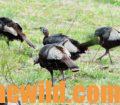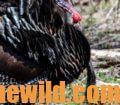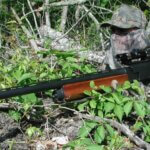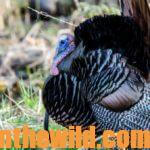Editor’s Note: Today, 34-year-old Ryan Solomon of Aguilar, Colorado, spends a portion of turkey season each year in Colorado guiding for western turkeys for Fulldraw Outfitters (https://www.fulldrawoutfitters.com/). However, he’s spent most of his life in Georgia on his family’s 9,500-acre Gopher Plantation (http://www.gopherplantation.com/) guiding for eastern wild turkeys. We’ve asked Solomon to tell us the difference in calling Merriam’s and Rio Grande gobblers in the West and eastern gobblers.
 Back home in Georgia, I like to use a really-raspy call, a Woodhaven Red Wasp 3 Reed V cut
Back home in Georgia, I like to use a really-raspy call, a Woodhaven Red Wasp 3 Reed V cut
(https://woodhavencustomcalls.com/shop/red-wasp/). Our birds seem to love that old, nasty, raspy call. Soft calling seems to kill more eastern birds than a lot of loud calling does. When calling, I’ll go silent on a Georgia turkey much quicker than I will on a Merriam’s turkey. Now, I like to hear a turkey gobble just like anyone else does, but I’d rather see them harvested than hear them gobble.
I also guide for Osceola turkeys in Florida, and when I’m calling to an Osceola, as soon as I hear him coming, I’ll go silent and not call to him. With Merriam’s gobblers, I’ve actually seen those turkeys lose interest in my calling because I haven’t been calling to them enough. Once you get a Merriam’s gobbler fired-up and talking to you, you generally can call him all the way up to the gun barrel. But of course, like with any turkey, I’ll take his temperature to see how fired-up he is, and I’ll call to these Merriam’s the way they call to me.
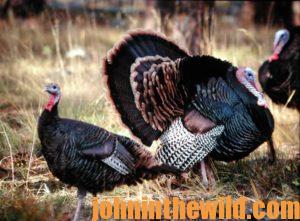 The other thing I’ve noticed about Merriam’s turkeys is they seem to like a cleaner, clearer call than the eastern or Osceola turkeys do. They’re not a big fan of rasp in a call. Also, when calling Merriam’s gobblers or Rio Grande gobblers, I use the kee-kee call much more on these western birds than I do on gobblers in the East. I’ve listened to flocks of Merriam’s and Rios, and I hear many more kee-kee calls than I do with flocks of eastern gobblers or Osceolas.
The other thing I’ve noticed about Merriam’s turkeys is they seem to like a cleaner, clearer call than the eastern or Osceola turkeys do. They’re not a big fan of rasp in a call. Also, when calling Merriam’s gobblers or Rio Grande gobblers, I use the kee-kee call much more on these western birds than I do on gobblers in the East. I’ve listened to flocks of Merriam’s and Rios, and I hear many more kee-kee calls than I do with flocks of eastern gobblers or Osceolas.
Another big difference in calling eastern and western turkeys is I usually can call Rios and Merriam’s from much further away than I can easterns or Osceolas. I believe in using whatever tactics are legal in the states where I’m hunting. Also, I use the technique of fanning where the hunter holds-up a real tail fan or a half-body turkey decoy in one hand and then crawls out into a field where a gobbler is either with hens or strutting by himself. A turkey usually will come walking or running to that decoy, and the hunter then can shoot the gobbler when he’s in close enough. The Rio Grande turkey and the Merriam’s turkey will commit (start walking or running toward that decoy) much quicker than the eastern turkeys do. Even the Osceola gobblers will commit quicker to this form of turkey hunting than the eastern turkeys will, especially if there are two or more turkeys together, and you go after them at the right time of day.
 What I’ve learned about these Colorado Merriam’s turkeys where I guide is they don’t like seeing a full tail feather fan or a half-body gobbler decoy. I’m much more effective by getting in some bushes wearing full camouflage and letting those Rios gobblers see just the tips of a Rio Grande’s fan above the bushes. The Merriam’s gobbler seems to become less interested in coming to a call if you only call to him occasionally. If western birds see the entire fan or those half-body gobbler decoys, they don’t come in as quickly as they will if they only see the tips of a Merriam’s turkey’s tail feather in the bushes. My favorite decoy is the half-body decoy with head, wings and tail feathers. By using decoys, I’ve been able to shoot Merriam’s gobblers with a bow by crawling up close to them and then drawing my bow and releasing.
What I’ve learned about these Colorado Merriam’s turkeys where I guide is they don’t like seeing a full tail feather fan or a half-body gobbler decoy. I’m much more effective by getting in some bushes wearing full camouflage and letting those Rios gobblers see just the tips of a Rio Grande’s fan above the bushes. The Merriam’s gobbler seems to become less interested in coming to a call if you only call to him occasionally. If western birds see the entire fan or those half-body gobbler decoys, they don’t come in as quickly as they will if they only see the tips of a Merriam’s turkey’s tail feather in the bushes. My favorite decoy is the half-body decoy with head, wings and tail feathers. By using decoys, I’ve been able to shoot Merriam’s gobblers with a bow by crawling up close to them and then drawing my bow and releasing.
If you’ve got a gobbler in a field with hens, when he spots that decoy, he may come running in – if you’re 300-yards away. But, another gobbler with hens, if he sees a decoy, you may have to crawl within 100 yards of that turkey and his hens before the gobbler will break away from the hens and come walking or running toward your decoy.
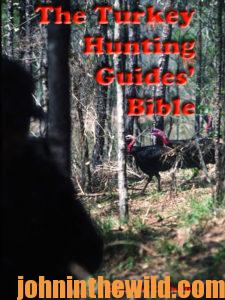 To learn more about turkey hunting, check out John E. Phillips’s book, “The Turkey Hunting Guides’ Bible,” at https://www.amazon.com/gp/product/B01ITWYY2K/ref=dbs_a_def_rwt_hsch_vapi_taft_p2_i11 and available in Kindle, print and Audible versions. You may have to cut and paste this link into your browser. (When you click on this book, notice on the left where Amazon says you can read 10% of the books for free and hear 10% for free). To learn more about other turkey books by John E. Phillips, go to www.amazon.com/author/johnephillips.
To learn more about turkey hunting, check out John E. Phillips’s book, “The Turkey Hunting Guides’ Bible,” at https://www.amazon.com/gp/product/B01ITWYY2K/ref=dbs_a_def_rwt_hsch_vapi_taft_p2_i11 and available in Kindle, print and Audible versions. You may have to cut and paste this link into your browser. (When you click on this book, notice on the left where Amazon says you can read 10% of the books for free and hear 10% for free). To learn more about other turkey books by John E. Phillips, go to www.amazon.com/author/johnephillips.
Tomorrow: Roost Tactics for Western and Eastern Turkeys with Guide Ryan Solomon

